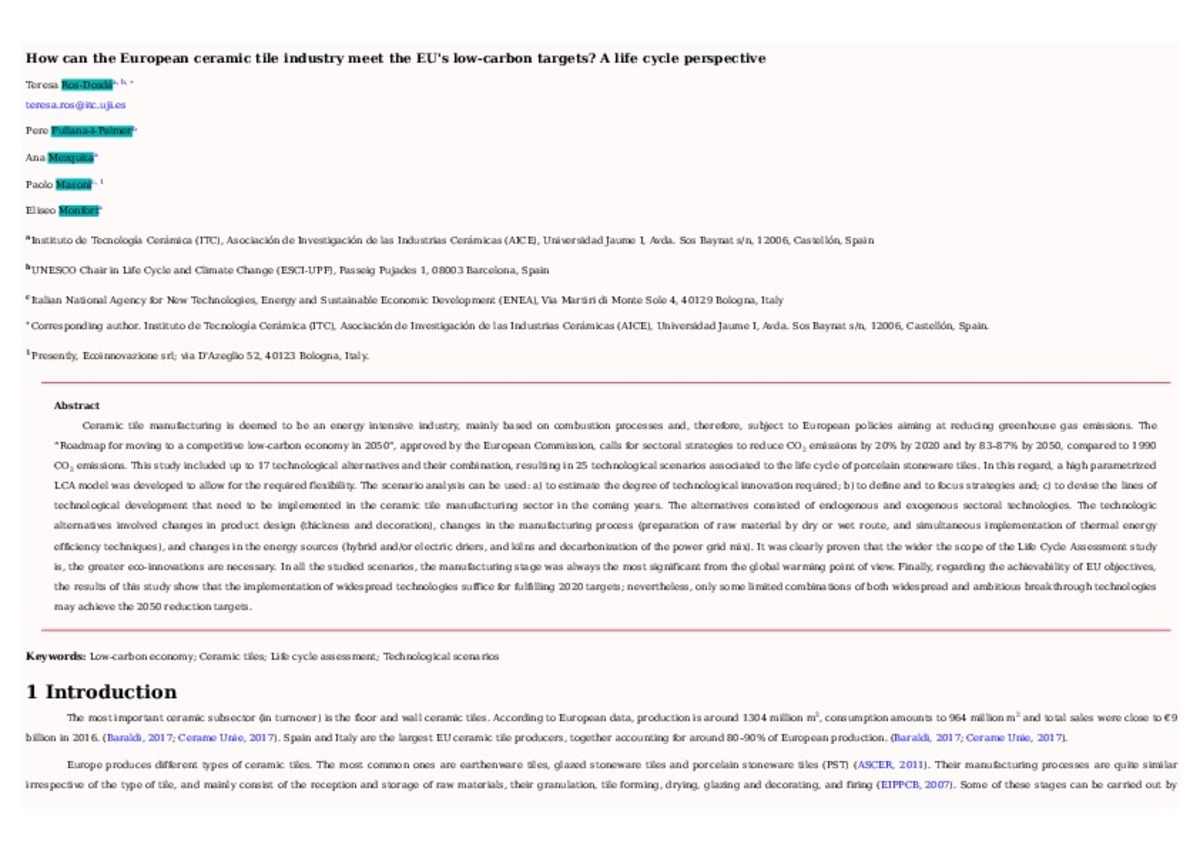Mostrar el registro sencillo del ítem
How can the European ceramic tile industry meet the EU's low-carbon targets? A life cycle perspective
| dc.contributor.author | Ros Dosdá, Teresa | |
| dc.contributor.author | Fullana-i-Palmer, Pere | |
| dc.contributor.author | Mezquita, Ana | |
| dc.contributor.author | Masoni, Paolo | |
| dc.contributor.author | Monfort, Eliseo | |
| dc.date.accessioned | 2018-11-15T11:44:57Z | |
| dc.date.available | 2018-11-15T11:44:57Z | |
| dc.date.issued | 2018-07 | |
| dc.identifier.citation | ROS-DOSDÁ, Teresa, et al. How can the European ceramic tile industry meet the EU's low-carbon targets? A life cycle perspective. Journal of Cleaner Production, 2018, 199: 554-564. | ca_CA |
| dc.identifier.uri | http://hdl.handle.net/10234/177502 | |
| dc.description.abstract | Ceramic tile manufacturing is deemed to be an energy intensive industry, mainly based on combustion processes and, therefore, subject to European policies aiming at reducing greenhouse gas emissions. The “Roadmap for moving to a competitive low-carbon economy in 2050”, approved by the European Commission, calls for sectoral strategies to reduce CO2 emissions by 20% by 2020 and by 83–87% by 2050, compared to 1990 CO2 emissions. This study included up to 17 technological alternatives and their combination, resulting in 25 technological scenarios associated to the life cycle of porcelain stoneware tiles. In this regard, a high parametrized LCA model was developed to allow for the required flexibility. The scenario analysis can be used: a) to estimate the degree of technological innovation required; b) to define and to focus strategies and; c) to devise the lines of technological development that need to be implemented in the ceramic tile manufacturing sector in the coming years. The alternatives consisted of endogenous and exogenous sectoral technologies. The technologic alternatives involved changes in product design (thickness and decoration), changes in the manufacturing process (preparation of raw material by dry or wet route, and simultaneous implementation of thermal energy efficiency techniques), and changes in the energy sources (hybrid and/or electric driers, and kilns and decarbonization of the power grid mix). It was clearly proven that the wider the scope of the Life Cycle Assessment study is, the greater eco-innovations are necessary. In all the studied scenarios, the manufacturing stage was always the most significant from the global warming point of view. Finally, regarding the achievability of EU objectives, the results of this study show that the implementation of widespread technologies suffice for fulfilling 2020 targets; nevertheless, only some limited combinations of both widespread and ambitious breakthrough technologies may achieve the 2050 reduction targets. | ca_CA |
| dc.format.extent | 10 p. | ca_CA |
| dc.format.mimetype | application/pdf | ca_CA |
| dc.language.iso | eng | ca_CA |
| dc.publisher | Elsevier | ca_CA |
| dc.rights | © 2018 Published by Elsevier Ltd. | ca_CA |
| dc.rights.uri | http://rightsstatements.org/vocab/InC/1.0/ | * |
| dc.subject | low-carbon economy | ca_CA |
| dc.subject | ceramic tiles | ca_CA |
| dc.subject | life cycle assessment | ca_CA |
| dc.subject | technological scenarios | ca_CA |
| dc.title | How can the European ceramic tile industry meet the EU's low-carbon targets? A life cycle perspective | ca_CA |
| dc.type | info:eu-repo/semantics/article | ca_CA |
| dc.identifier.doi | https://doi.org/10.1016/j.jclepro.2018.07.176 | |
| dc.relation.projectID | Instituto Valenciano de Competitividad Empresarial (IVACE) and the European Regional Development Fund [grant numbers IMDEEA/2014/12 and IMDEEA/2015/11] ; Climate KIC (Knowledge and Innovation Community) through the Pioneer into Practice Program [grant number AREP0047_2014-3.4-174_P062-01]. | ca_CA |
| dc.rights.accessRights | info:eu-repo/semantics/openAccess | ca_CA |
| dc.relation.publisherVersion | https://www.sciencedirect.com/science/article/pii/S0959652618321656 | ca_CA |
| dc.date.embargoEndDate | 2020-07 | |
| dc.type.version | info:eu-repo/semantics/updatedVersion | ca_CA |
Ficheros en el ítem
Este ítem aparece en la(s) siguiente(s) colección(ones)
-
ITC_Articles [74]







